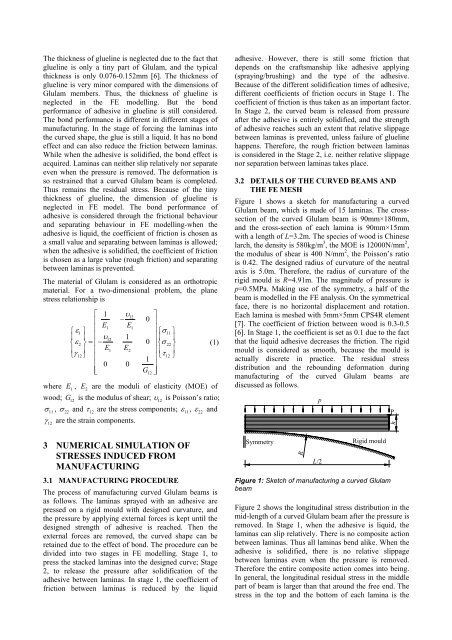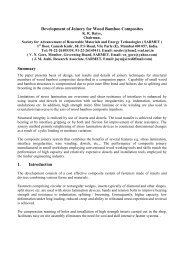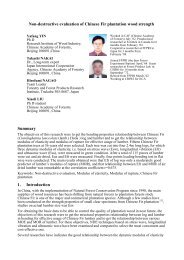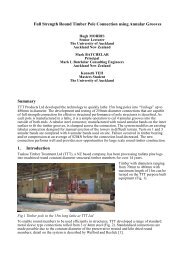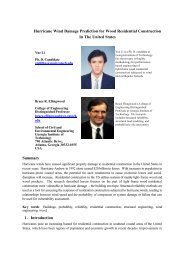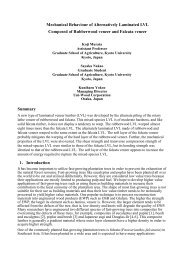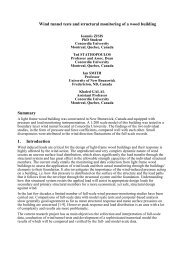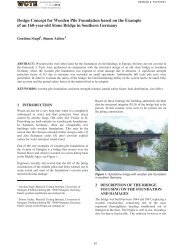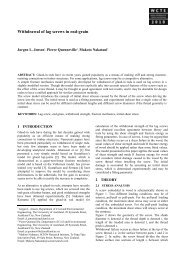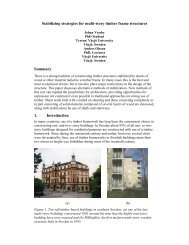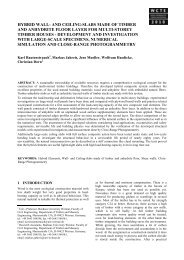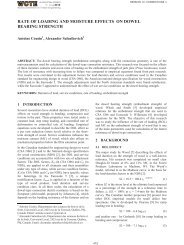simulation of residual stress in curved glulam beams - Engineered ...
simulation of residual stress in curved glulam beams - Engineered ...
simulation of residual stress in curved glulam beams - Engineered ...
Create successful ePaper yourself
Turn your PDF publications into a flip-book with our unique Google optimized e-Paper software.
The thickness <strong>of</strong> gluel<strong>in</strong>e is neglected due to the fact that<br />
gluel<strong>in</strong>e is only a t<strong>in</strong>y part <strong>of</strong> Glulam, and the typical<br />
thickness is only 0.076-0.152mm [6]. The thickness <strong>of</strong><br />
gluel<strong>in</strong>e is very m<strong>in</strong>or compared with the dimensions <strong>of</strong><br />
Glulam members. Thus, the thickness <strong>of</strong> gluel<strong>in</strong>e is<br />
neglected <strong>in</strong> the FE modell<strong>in</strong>g. But the bond<br />
performance <strong>of</strong> adhesive <strong>in</strong> gluel<strong>in</strong>e is still considered.<br />
The bond performance is different <strong>in</strong> different stages <strong>of</strong><br />
manufactur<strong>in</strong>g. In the stage <strong>of</strong> forc<strong>in</strong>g the lam<strong>in</strong>as <strong>in</strong>to<br />
the <strong>curved</strong> shape, the glue is still a liquid. It has no bond<br />
effect and can also reduce the friction between lam<strong>in</strong>as.<br />
While when the adhesive is solidified, the bond effect is<br />
acquired. Lam<strong>in</strong>as can neither slip relatively nor separate<br />
even when the pressure is removed. The deformation is<br />
so restra<strong>in</strong>ed that a <strong>curved</strong> Glulam beam is completed.<br />
Thus rema<strong>in</strong>s the <strong>residual</strong> <strong>stress</strong>. Because <strong>of</strong> the t<strong>in</strong>y<br />
thickness <strong>of</strong> gluel<strong>in</strong>e, the dimension <strong>of</strong> gluel<strong>in</strong>e is<br />
neglected <strong>in</strong> FE model. The bond performance <strong>of</strong><br />
adhesive is considered through the frictional behaviour<br />
and separat<strong>in</strong>g behaviour <strong>in</strong> FE modell<strong>in</strong>g-when the<br />
adhesive is liquid, the coefficient <strong>of</strong> friction is chosen as<br />
a small value and separat<strong>in</strong>g between lam<strong>in</strong>as is allowed;<br />
when the adhesive is solidified, the coefficient <strong>of</strong> friction<br />
is chosen as a large value (rough friction) and separat<strong>in</strong>g<br />
between lam<strong>in</strong>as is prevented.<br />
The material <strong>of</strong> Glulam is considered as an orthotropic<br />
material. For a two-dimensional problem, the plane<br />
<strong>stress</strong> relationship is<br />
⎡ 1 υ12<br />
⎤<br />
⎢ − 0 ⎥<br />
E1 E1<br />
⎧ε1 ⎫ ⎢ ⎥⎧σ11⎫<br />
⎪ ⎪ ⎢ υ12<br />
1 ⎥⎪<br />
⎪<br />
⎨ε2 ⎬= ⎢− 0 ⎥⎨σ22⎬<br />
(1)<br />
⎪ E1 E2<br />
γ ⎪ ⎢ ⎥⎪<br />
12 τ ⎪<br />
⎩ ⎭ ⎢ 12<br />
1 ⎥⎩<br />
⎭<br />
⎢ 0 0 ⎥<br />
⎢⎣ G12<br />
⎥⎦<br />
where 1 E , 2<br />
wood; 12 G is the modulus <strong>of</strong> shear; υ 12 is Poisson’s ratio;<br />
E are the moduli <strong>of</strong> elasticity (MOE) <strong>of</strong><br />
σ 11 , σ 22 and τ 12 are the <strong>stress</strong> components; ε 11 , ε 22 and<br />
γ are the stra<strong>in</strong> components.<br />
12<br />
3 NUMERICAL SIMULATION OF<br />
STRESSES INDUCED FROM<br />
MANUFACTURING<br />
3.1 MANUFACTURING PROCEDURE<br />
The process <strong>of</strong> manufactur<strong>in</strong>g <strong>curved</strong> Glulam <strong>beams</strong> is<br />
as follows. The lam<strong>in</strong>as sprayed with an adhesive are<br />
pressed on a rigid mould with designed curvature, and<br />
the pressure by apply<strong>in</strong>g external forces is kept until the<br />
designed strength <strong>of</strong> adhesive is reached. Then the<br />
external forces are removed, the <strong>curved</strong> shape can be<br />
reta<strong>in</strong>ed due to the effect <strong>of</strong> bond. The procedure can be<br />
divided <strong>in</strong>to two stages <strong>in</strong> FE modell<strong>in</strong>g. Stage 1, to<br />
press the stacked lam<strong>in</strong>as <strong>in</strong>to the designed curve; Stage<br />
2, to release the pressure after solidification <strong>of</strong> the<br />
adhesive between lam<strong>in</strong>as. In stage 1, the coefficient <strong>of</strong><br />
friction between lam<strong>in</strong>as is reduced by the liquid<br />
adhesive. However, there is still some friction that<br />
depends on the craftsmanship like adhesive apply<strong>in</strong>g<br />
(spray<strong>in</strong>g/brush<strong>in</strong>g) and the type <strong>of</strong> the adhesive.<br />
Because <strong>of</strong> the different solidification times <strong>of</strong> adhesive,<br />
different coefficients <strong>of</strong> friction occurs <strong>in</strong> Stage 1. The<br />
coefficient <strong>of</strong> friction is thus taken as an important factor.<br />
In Stage 2, the <strong>curved</strong> beam is released from pressure<br />
after the adhesive is entirely solidified, and the strength<br />
<strong>of</strong> adhesive reaches such an extent that relative slippage<br />
between lam<strong>in</strong>as is prevented, unless failure <strong>of</strong> gluel<strong>in</strong>e<br />
happens. Therefore, the rough friction between lam<strong>in</strong>as<br />
is considered <strong>in</strong> the Stage 2, i.e. neither relative slippage<br />
nor separation between lam<strong>in</strong>as takes place.<br />
3.2 DETAILS OF THE CURVED BEAMS AND<br />
THE FE MESH<br />
Figure 1 shows a sketch for manufactur<strong>in</strong>g a <strong>curved</strong><br />
Glulam beam, which is made <strong>of</strong> 15 lam<strong>in</strong>as. The crosssection<br />
<strong>of</strong> the <strong>curved</strong> Glulam beam is 90mm×180mm,<br />
and the cross-section <strong>of</strong> each lam<strong>in</strong>a is 90mm×15mm<br />
with a length <strong>of</strong> L=3.2m. The species <strong>of</strong> wood is Ch<strong>in</strong>ese<br />
larch, the density is 580kg/m 3 , the MOE is 12000N/mm 2 ,<br />
the modulus <strong>of</strong> shear is 400 N/mm 2 , the Poisson’s ratio<br />
is 0.42. The designed radius <strong>of</strong> curvature <strong>of</strong> the neutral<br />
axis is 5.0m. Therefore, the radius <strong>of</strong> curvature <strong>of</strong> the<br />
rigid mould is R=4.91m. The magnitude <strong>of</strong> pressure is<br />
p=0.5MPa. Mak<strong>in</strong>g use <strong>of</strong> the symmetry, a half <strong>of</strong> the<br />
beam is modelled <strong>in</strong> the FE analysis. On the symmetrical<br />
face, there is no horizontal displacement and rotation.<br />
Each lam<strong>in</strong>a is meshed with 5mm×5mm CPS4R element<br />
[7]. The coefficient <strong>of</strong> friction between wood is 0.3-0.5<br />
[6]. In Stage 1, the coefficient is set as 0.1 due to the fact<br />
that the liquid adhesive decreases the friction. The rigid<br />
mould is considered as smooth, because the mould is<br />
actually discrete <strong>in</strong> practice. The <strong>residual</strong> <strong>stress</strong><br />
distribution and the rebound<strong>in</strong>g deformation dur<strong>in</strong>g<br />
manufactur<strong>in</strong>g <strong>of</strong> the <strong>curved</strong> Glulam <strong>beams</strong> are<br />
discussed as follows.<br />
Symmetry<br />
R<br />
p<br />
L/2<br />
Rigid mould<br />
Figure 1: Sketch <strong>of</strong> manufactur<strong>in</strong>g a <strong>curved</strong> Glulam<br />
beam<br />
P<br />
h<br />
Figure 2 shows the longitud<strong>in</strong>al <strong>stress</strong> distribution <strong>in</strong> the<br />
mid-length <strong>of</strong> a <strong>curved</strong> Glulam beam after the pressure is<br />
removed. In Stage 1, when the adhesive is liquid, the<br />
lam<strong>in</strong>as can slip relatively. There is no composite action<br />
between lam<strong>in</strong>as. Thus all lam<strong>in</strong>as bend alike. When the<br />
adhesive is solidified, there is no relative slippage<br />
between lam<strong>in</strong>as even when the pressure is removed.<br />
Therefore the entire composite action comes <strong>in</strong>to be<strong>in</strong>g.<br />
In general, the longitud<strong>in</strong>al <strong>residual</strong> <strong>stress</strong> <strong>in</strong> the middle<br />
part <strong>of</strong> beam is larger than that around the free end. The<br />
<strong>stress</strong> <strong>in</strong> the top and the bottom <strong>of</strong> each lam<strong>in</strong>a is the


